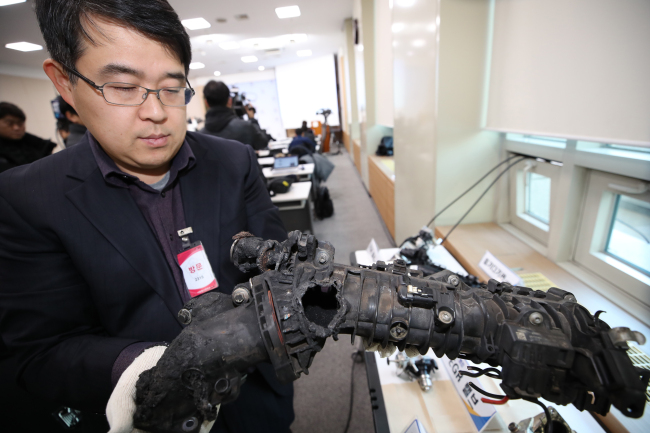South Korea’s Transportation Ministry confirmed Monday the cause of BMW engine fires that sent jitters across the country this summer was the faulty exhaust gas recirculation cooler, and slapped an 11.2 billion won ($9.9 million) fine on the German carmaker for concealing and downplaying the defect.
The investigation team consisting of government officials and auto professionals released the final result, including plans to file criminal charges against the German luxury automaker and for the adoption of stricter recall measures.
BMW was slapped with an 11.2 billion won fine on grounds that the BMW headquarters first knew of the defect in 2015 and formed a task force in the following year to deal with the defect, the investigation team said.
“The BMW fires were caused by flaws in design, which led to the boiling of the coolant, which in turn created a crack in the EGR cooler, ultimately leading the coolant to leak and ignite fires in certain conditions,” said Lee Gwang-bum, co-leader of the investigation team, during a press briefing at the government complex in northern Seoul.
“There needs to be an explanation by BMW regarding the findings and further investigation by researchers,” Lee added.
In essence, government findings coincided with BMW’s explanation that the faulty EGR had led to engine fires of its vehicles in use, but differed in terms of when the automaker first became aware of the danger.
Ruling out the possibility of defects in the electronic control unit that controls the EGR, the ministry said “there is no problem with the software.”
BMW vehicles catching fire on roads gained attention across the nation this summer, prompting the Transport Ministry to advise BMW owners to avoid using their cars in August. Apartments, office buildings and parking lots also banned the entry and parking of BMW cars.
In efforts to contain the damage, BMW Korea voluntarily recalled some 170,000 units containing the problematic EGR in July and October, following an official apology made by BMW Korea Chairman Kim Hyo-joon.
The total number of BMW cars that caught fire came to 52 units between the January to November period, the ministry said.
Refuting BMW’s stance that it first found out about the EGR defect this July, the investigation team said, “We cannot assertively say BMW deceived (consumers about the defect). But based on the circumstances, including the operation of the task force, it can be surmised that a company with the level of technology of BMW would have known about the situation.”
According to the investigation team, the BMW headquarters formed a task force in October 2015 to deal with cracks in the EGR cooler. A separate task force to deal with complaints about intake manifold was put together in November 2016, and changes were made to the engine design.
Regarding such a claim, BMW Korea said, “The task force discovered the correlation between damages reported and the EGR cooler this July.”
 |
An official on the investigation team shows an EGR cooler with a hole made due to flaws in design at a press briefing at a government complex in Seoul. (Yonhap) |
Claiming that BMW deliberately concealed and downplayed the defects, the ministry fined the automaker 11.2 billion won for 22,670 vehicles released after June 2016.
About a fifth of BMW cars equipped with the faulty EGR received a penalty as a stipulation regarding the penalty was newly included in South Korea’s Automobile Management Act amended in June 2016.
Upon the announcement, BMW said in a statement, “The statement issued by the (ministry) confirms that the leakage of coolant from the EGR cooler is the root cause for the rare occurrence of thermal events. The findings of (the ministry) are generally in line with the results of thorough technical examinations by the BMW Group,”
Explaining that exchaning the faulty hardware would solve the issue, the automaker went on to say, “The intake manifold itself has no design flaw and can only be damaged as a result of a leaky EGR-cooler. For this reason we are in alignment with (the ministry) that the intake manifold should be replaced in the event of a leaky EGR-cooler.”
Explaining that it was in the process of replacing the intake manifold of vehicles that have experienced EGR cooler leakage, the firm said it apologizes for the inconvenience to the customers and the general public.
By Kim Bo-gyung (
lisakim425@heraldcorp.com)








